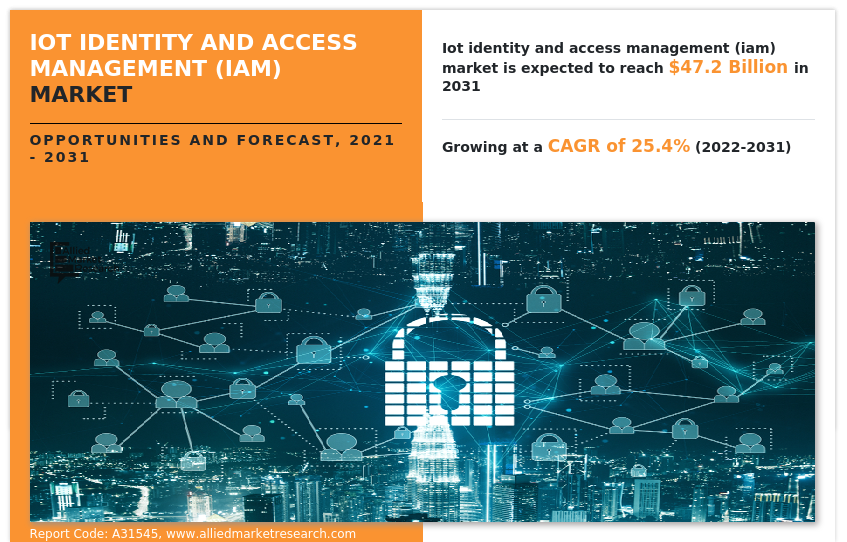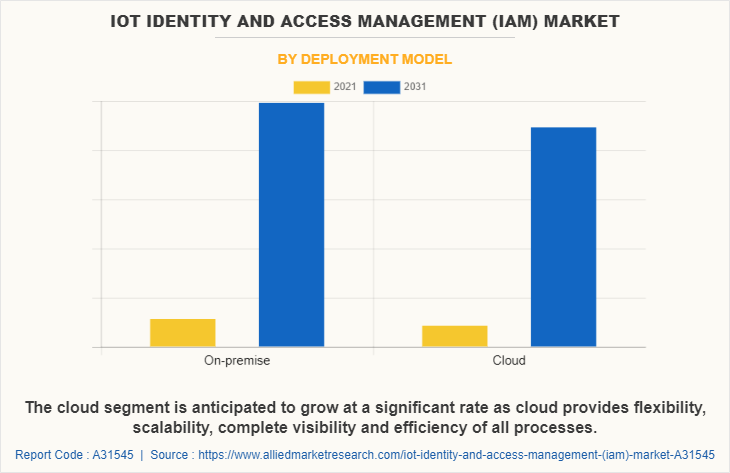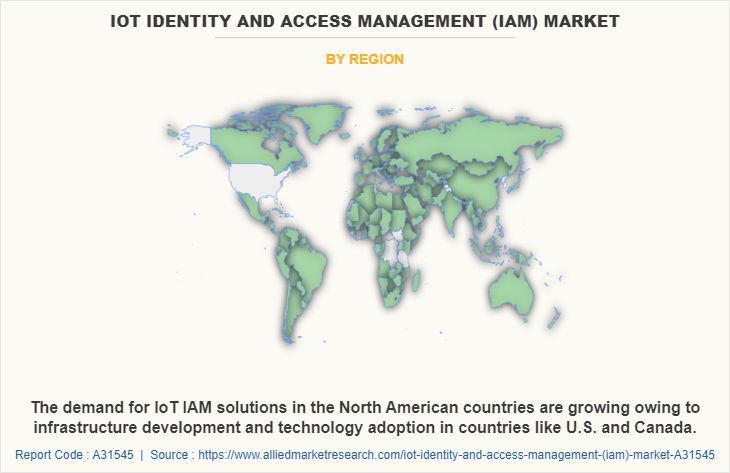Iot Identity And Access Management (IAM) Market Research, 2031
The global Iot Identity And Access Management Market Size was valued at $4.9 billion in 2021, and is projected to reach $47.2 billion by 2031, growing at a CAGR of 25.4% from 2022 to 2031.
Rising security breaches and heightened identity fraud cases, increasing awareness regarding compliance controls, growing need for IAM for IoT, and increasing spending on cyber security are key factors driving the growth of the IoT IAM market. In addition, cultural shift from traditional IAM to IoT IAM boosts the market growth. However, the high cost associated with the implementation and maintenance of IoT identity and access management (IAM) solution and the increase in security & privacy concerns hamper the Iot Identity And Access Management market growth. Furthermore, proliferation of cloud-based IAM solutions and services, growth in the adoption of hybrid cloud models and technologies such as AI, ML, blockchain, and biometrics for identity and access management provide ample growth opportunities for the IoT IAM industry growth.

IoT identity access management (IAM), also known as identity management, is an IT discipline, framework, and security solution for managing the identity of IoT devices. IoT identity access management provides a fundamental security component that prevents unauthorized users from accessing IoT ecosystem. IoT devices are focused on connecting things, people, tools, and applications, and IoT identity access management provides end-to-end encryption, overload detection, and unauthorized access removal to help build strong security features. The iot identity and access management (iam) market is segmented into Offering, Deployment Model, Security Type, Enterprise Size and Industry Vertical.
Segment Review
The IoT identity and access management market analysis is segmented on the basis of offering, deployment mode, enterprise size, security type, industry vertical, and region. On the basis of offering, the market is segmented into solution and services. On the basis of solution, the market is segmented into lifecycle management, authentication, audit, compliance and governance, password management, others. Furthermore, the service segment is divided into professional and managed services.
Moreover, the professional services segment is divided into training & education, integration & implementation, and support & maintenance. According to organization size, the market is fragmented into large enterprises and SMEs. On the basis of deployment, the market is classified into cloud and on-premise. Depending on security type, it is segregated into cloud security, network security, endpoint security, application security, and others. By industry vertical, it is segmented into BFSI, healthcare, retail, manufacturing, IT & telecom, energy & utilities, automotive & transportation, and others. Region-wise, the market is analyzed across North America, Europe, Asia-Pacific, and LAMEA.
The key players that operate in the Iot Identity And Access Management Industry are Telefonaktiebolaget LM Ericsson, AWS, Google LLC, Microsoft, IBM, Cisco Systems, Inc., Oracle, HID Global Corporation, DigiCert, Inc., Keyfactor, Entrust Corporation, GlobalSign, One Identity, LLC, KaaIoT Technologies, LLC, Sailpoint Technologies Holdings, Inc., Optiv Security, Inc., and IdentityFusion, Inc. These players have adopted various strategies to increase their market penetration and strengthen their position in the Iot Identity And Access Management Industry.
On the basis of deployment mode, the on-premise segment captured the largest IoT Identity and access management market in 2021, and is expected to continue this trend during the forecast period. This is attributed to numerous advantages offered by the on-premises deployment such as a high level of data security and safety. Companies prefer on-premises model, owing to high data security and less data breach as compared to cloud based deployment models, which further drives demand for on-premises deployment model across sectors.
However, the cloud segment is expected to witness highest growth in the upcoming years. Owing to rise in adoption of cloud-based IoT IAM, due to low cost and easier maintenance, is expected to witness the highest growth in the upcoming year. In addition, it provides flexibility and scalability to boost business processes, which propels growth of the IoT identity and access management market.

Depending on the region, North America dominated the market in 2021. Rise in usage of IoT identity and access management (IAM) in healthcare, government, and banking & finance for security purposes to improve businesses and customer experience is expected to provide lucrative growth opportunities for the IoT identity and access management (IAM) market in North America. However, Asia-Pacific is expected to exhibit highest growth during the forecast period. The region has a robust IT infrastructure and solid software and service offerings. In addition, rise in penetration of cloud-based services and increase in demand for IAM in healthcare retail and sectors to enhance business operations drive growth of the IoT identity and access management market in this region.

The report focuses on growth prospects, restraints, and analysis of the Iot Identity And Access Management Market Trends. The study provides Porter’s five forces analysis to understand the impact of various factors, such as bargaining power of suppliers, competitive intensity of competitors, threat of new entrants, threat of substitutes, and bargaining power of buyers on the global IoT Identity and access management market share.
Top Impacting Factors
Increased integration of IAM with IoT Devices
IAM systems are evolving to accommodate Identity of Things. IAM vendors are constantly working on adding device centric capabilities into their existing IAM solutions to address IoT-specific challenges. IAM vendors are reorganizing their solution portfolio to offer unified IAM solution including an integrated solution for employee IAM, customer IAM and IoT IAM solution. With the advent of several device centric IAM providers and predicted mergers and acquisitions in this field, market dynamics and technology evolution are expected to evolve. On the contrary, IoT IAM market is still in the nascent stage with the presence of multiple vendors reorganizing their unified IAM solutions to support the requirement of IoT IAM solution.
Additionally, the specialized IoT IAM vendors are engaging with numerous small scale and pilot projects to establish the authenticity and effectiveness of a purpose-built IoT IAM solution. IoT IAM market is expected to evolve towards an integrated IoT security solution to include the integrated solution for root-of-trust, device-centric identity and access management, end-to-end data security, comprehensive device visibility and granular access control, and others.
Rapid digitization toward businesses operation
Organizations are facing digital transformation to support the shift to remote working. Many have been impacted by major security concerns that have emerged. Digital transformation has been helping organizations become more agile, cost-effective, and productive for years. Furthermore, the COVID-19 pandemic has led to the adoption of remote work mechanisms by numerous companies on a large scale, which in turn, increases the risk of digital risk, thus resulting in speedy application of IoT identity and access management (IAM) solutions by various firms and organizations.
Furthermore, increase in vulnerability of connected devices to fight against security risk and malware attacks escalates the demand for robust and integrated IoT identity and access management (IAM) solutions across organizations to run their business safely and securely as well as enhance digitalization, thus augmenting the growth of the global IoT identity and access management (IAM) market.
COVID-19 Impact Analysis
The market is expected to grow rapidly after the pandemic, owing to rise in adoption of work-from-home culture across the globe. Furthermore, increase in cyber risk and new vulnerabilities is leading organizations worldwide to rethink their security setups. To manage employees working from home, companies rely extensively on remote-based monitoring of the workforce, enhancing the demand for IoT solutions. This helps bring transparency, provide real-time tracking, improve safety, and ensure meeting government compliance. However, the cybersecurity of remote workforce and enterprises plays a vital role in catering to their clients during lockdowns. Therefore, it offers opportunities for the IoT identity and access management market post pandemic.
Key Benefits for Stakeholders
- The study provides an in-depth analysis of the Iot Identity And Access Management Market Forecast along with current & future trends to explain the imminent investment pockets.
- Information about key drivers, restraints, & opportunities and their impact analysis on Iot Identity And Access Management Market Analysisis provided in the report.
- The Porter’s five forces analysis illustrates the potency of the buyers and suppliers operating in the industry.
- The IoT IAM market analysis from 2022 to 2031 is provided to determine the market potential.
Iot Identity And Access Management (Iam) Market Report Highlights
| Aspects | Details |
| Market Size By 2031 | USD 47.2 billion |
| Growth Rate | CAGR of 25.4% |
| Forecast period | 2021 - 2031 |
| Report Pages | 334 |
| By Offering |
|
| By Deployment Model |
|
| By Security Type |
|
| By Enterprise Size |
|
| By Industry Vertical |
|
| By Region |
|
| Key Market Players | Amazon Web Service (AWS), SailPoint Technologies Holdings, Inc., KaaIoT Technologies, LLC., one identity, LM Ericsson, GlobalSign, Google LLC, Oracle Corporation, .IBM CORPORATION, Keyfactor, HID Global, IdentityFusion, DigiCert, Microsoft Corporation, Entrust Inc., Cisco Systems Inc., Optiv Security Inc. |
Analyst Review
According to CXOs of leading companies, advent of the internet of things (IoT) technologies and its widespread adoption in various sectors, including consumer sector, businesses, industrial, energy & utility, building & facilities, mobility, infrastructure, and others, are significantly transforming the way people, processes, and technologies are converging and driving improvements. However, increasing adoption of smart technologies also means increasing concern for security. Driven by the increased adoption of internet of things technologies, the scope of identity and access management technologies are no longer confined to just people. IoT has emerged as a popular trend that is transforming IAM technologies.
IoT IAM solution capability includes massive scalability & availability to handle a wide variety and volume of IoT devices, secure device registration & provisioning, end-to-end data encryption, device authentication, compliance management, and centralized policy management, identity & device lifecycle management, certificates and key management, API management and security. Such factors drive growth of the market.
On the contrary, organizations are embracing security-by-design philosophies to secure IoT devices, which means security is built in from the start to add trust to the devices rather than after an attack. IoT security vendors are progressively collaborating with device manufacturers to guarantee that security keys and certificates are provisioned during the manufacturing process, ensuring a robust root of trust. These security keys and certificates can be used for secure and automated registration and onboarding of IoT devices, as well as secure operation. Furthermore, IoT IAM vendors are working on providing end-to-end data encryption in IoT devices and securing data-at-rest and data-in-transit between devices and users. IoT security vendors are focusing on integrated features to ensure data security and privacy are effectively connected with device identification and root-of-trust to enable end-to-end IoT security.
Moreover, organizations are shifting toward digitalization and increase in implementation of Industry 4.0 to cope with ongoing tough business competition and rising cyber-attacks. This eventually creates the need for IoT identity and access management (IAM) solution in sectors, which provide the lucrative opportunities for the market growth.
Rising security breaches and heightened identity fraud cases, increasing awareness regarding compliance controls, growing need for IAM for IoT, and increasing spending on cyber security are key factors driving the growth of the IoT IAM market. In addition, cultural shift from traditional IAM to IoT IAM boosts the market growth.
Depending on the region, North America dominated the market in 2021. Rise in usage of IoT identity and access management (IAM) in healthcare, government, and banking & finance for security purposes to improve businesses and customer experience is expected to provide lucrative growth opportunities for the IoT identity and access management (IAM) market in North America.
The global IoT identity and access management (IAM) market size was valued at $4,926.34 million in 2021, and is projected to reach $47,149.02 million by 2031, registering a CAGR of 25.4% from 2022 to 2031.
The key players that operate in the IoT IAM market are Telefonaktiebolaget LM Ericsson, AWS, Google LLC, Microsoft, IBM, Cisco Systems, Inc., Oracle, HID Global Corporation, DigiCert, Inc., Keyfactor, Entrust Corporation, GlobalSign, One Identity, LLC, KaaIoT Technologies, LLC, Sailpoint Technologies Holdings, Inc., Optiv Security, Inc., and IdentityFusion, Inc. These players have adopted various strategies to increase their market penetration and strengthen their position in the industry.
Loading Table Of Content...



